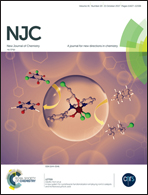Role of MoS2 and WS2 monolayers on photocatalytic hydrogen production and the pollutant degradation of monoclinic BiVO4: a first-principles study†
Abstract
The global dependence on exhaustible fossil fuel resources has made the search for an alternative renewable and sustainable fuel more urgent. Photocatalysis has gained increasing consideration as a promising technology to solve problems associated with solar energy conversion. Fabricated m-BiVO4-based heterostructures have shown improved photocatalytic activity for hydrogen evolution and pollutant degradation; however, a deeper understanding of the photocatalytic mechanism and the role of the monolayers is still lacking. Moreover, no theoretical studies have been carried out on MS2/m-BiVO4(010) heterostructures. In the present study, the roles of MoS2 and WS2 monolayers loaded onto a m-BiVO4 surface for active photocatalytic hydrogen production and pollutant degradation are explored using first-principle studies. Herein, hybrid density functional calculations and a long-range dispersion correction method were used to investigate the charge transfer, electronic properties, photocatalytic activity and mechanism of the MS2/m-BiVO4(010) heterostructures. The results showed a narrow band gap, built-in potential and a type-II band alignment for the MS2/m-BiVO4(010) heterostructures compared to pure m-BiVO4, which favour the separation and transfer of charge carriers and visible-light-driven activity. The MoS2/m-BiVO4 heterostructure showed a suitable band edge for hydrogen production and pollutant degradation compared to the WS2/m-BiVO4 heterostructure. This improvement was attributed to the role of the MoS2 monolayer as an electron donor, the many reactive sites on the MoS2 surface and the enhanced electron/hole pair separation of charge carriers at the MoS2/m-BiVO4(010) interface. Considering that the MS2 monolayer coupled with m-BiVO4 can restrain the electron–hole recombination rate without lattice distortion indicates that the heterostructure approach is better than the doping approach. Based on the analysis of the electronic properties, the MS2/m-BiVO4(010) heterostructures were shown to fit within the acceptable band gap and built-in potential range. The proposed theoretical design paves a way for the effective and large-scale fabrication of m-BiVO4-based photocatalyst for solar energy conversion and environmental remediation applications.



 Please wait while we load your content...
Please wait while we load your content...